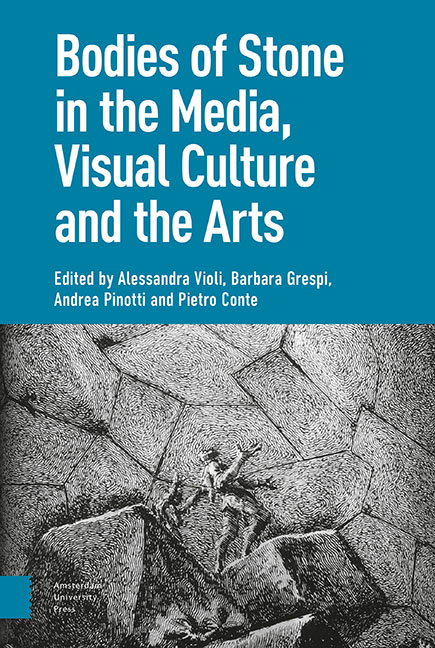Book contents
- Frontmatter
- Contents
- Introduction: Learning from Stone
- I Statue: The Imaginary of Uncertain Petrification
- 1 Theatre and Memory: The Body-as-Statue in Early Modern Culture
- 2 Translated Bodies: A ‘Cartographic’ Approach
- 3 Pantomime in Stone: Performance of the Pose and Animal Camouflage
- 4 Animated Statues and Petrified Bodies: A Journey Inside Fantasy Cinema
- 5 The Ephemeral Cathedral: Bodies of Stone and Configurations of Film
- II Matter: Size, Hardness, Duration
- 1 Bodies That Matter: Miniaturisation and the Origin(s) of ‘Art’
- 2 Brancusi’s ‘Sculpture for the Blind’
- 3 Cinema, Phenomenology and Hyperrealism
- 4 Ephemeral Bodies: The ‘Candles’ of Urs Fischer
- 5 The Celluloid and the Death Mask: Bazin’s and Eisenstein’s Image Anthropology
- III Corpse: Fossils, Auto-Icons, Revenants
- 1 Funeral Eulogy: Post-Mortem Figures and Redeemed Bodies, in Images
- 2 On Jack Torrance As a Fossil Form
- 3 Technical Images and the Transformation of Matter in Eighteenth-Century Tuscany
- 4 Glass, Mixed Media, Stone: The Bodily Stuffs of Suspended Animation
- 5 Bodies’ Strange Stories: Les Revenants and The Leftovers
- IV Monument: Embodying and Grafting
- 1 The Impassibly Fleshly, the Statue of the Impossible
- 2 Frozen into Allegory: Cleopatra’s Cultural Survival
- 3 The Orphan Image
- 4 The Well-Tempered Memorial: Abstraction, Anthropomorphism, Embodiment
- 5 Monuments of the Heart: Living Tombs and Organic Memories in Contemporary Culture
- Index
Introduction: Learning from Stone
Published online by Cambridge University Press: 20 November 2020
- Frontmatter
- Contents
- Introduction: Learning from Stone
- I Statue: The Imaginary of Uncertain Petrification
- 1 Theatre and Memory: The Body-as-Statue in Early Modern Culture
- 2 Translated Bodies: A ‘Cartographic’ Approach
- 3 Pantomime in Stone: Performance of the Pose and Animal Camouflage
- 4 Animated Statues and Petrified Bodies: A Journey Inside Fantasy Cinema
- 5 The Ephemeral Cathedral: Bodies of Stone and Configurations of Film
- II Matter: Size, Hardness, Duration
- 1 Bodies That Matter: Miniaturisation and the Origin(s) of ‘Art’
- 2 Brancusi’s ‘Sculpture for the Blind’
- 3 Cinema, Phenomenology and Hyperrealism
- 4 Ephemeral Bodies: The ‘Candles’ of Urs Fischer
- 5 The Celluloid and the Death Mask: Bazin’s and Eisenstein’s Image Anthropology
- III Corpse: Fossils, Auto-Icons, Revenants
- 1 Funeral Eulogy: Post-Mortem Figures and Redeemed Bodies, in Images
- 2 On Jack Torrance As a Fossil Form
- 3 Technical Images and the Transformation of Matter in Eighteenth-Century Tuscany
- 4 Glass, Mixed Media, Stone: The Bodily Stuffs of Suspended Animation
- 5 Bodies’ Strange Stories: Les Revenants and The Leftovers
- IV Monument: Embodying and Grafting
- 1 The Impassibly Fleshly, the Statue of the Impossible
- 2 Frozen into Allegory: Cleopatra’s Cultural Survival
- 3 The Orphan Image
- 4 The Well-Tempered Memorial: Abstraction, Anthropomorphism, Embodiment
- 5 Monuments of the Heart: Living Tombs and Organic Memories in Contemporary Culture
- Index
Summary
The extension of life to inert matter is one of the most fascinating turns taken by modernisation: over the nineteenth and twentieth centuries, the emergence of technologies that appear to be endowed with vital properties, sensory faculties and cognitive functions called into question the demarcation between the animate and the inanimate and opened a new vision of what it is to be an object. Or one might also say that it reactivated an ancient readiness to recognise the lives of things, which is the common denominator of various artistic experiences and, over the two centuries, has become the focus of a dedicated line of thought. Since the nineteenth century, this development has placed at centre stage the media both because, conceived of as nervous bodies, they occupy a special vantage point on reality and because, insofar as they are ‘technical objects’, they are endowed with their own life, intelligence and language. The cinema has been particularly fruitful in this animist turn, presenting itself as a machine able to breathe life into bodies and at the same time to reveal ‘the face of things’; not only the theories but also the films of Jean Epstein bear the most eloquent witness to this shared sensibility and have been the object of a widespread re-evaluation in recent cinema studies.
Nevertheless, the life of inorganic things that has been rediscovered by technology and the media raises an insistent question of significance for modern man, who is still faced with death. The fact of the cadaver remains the principle obstruction for the line of thought that envisages an osmosis between the animate and the inanimate, so much so that it has become the object of a specific imaginary that embraces photography, sculpture, archaeology and, above all, the sciences, within which stone—the material to which tends flesh bereft of life—takes on a wholly novel guise. The body of stonein its widest sense, running from the mere mineral object to the literally petrified cadaver, from the anthropomorphic statue to the monument, from the catatonic body to the fossil, from the miniature to the autoicon, thus offers us a privileged object of analysis through which to investigate a sort of secondary effect of animism: the aesthetics of suspension in between states—between life and death, organic and inorganic, animate and inanimate—taking account of both its anthropological roots and its modern and contemporary expressions.
- Type
- Chapter
- Information
- Publisher: Amsterdam University PressPrint publication year: 2020

